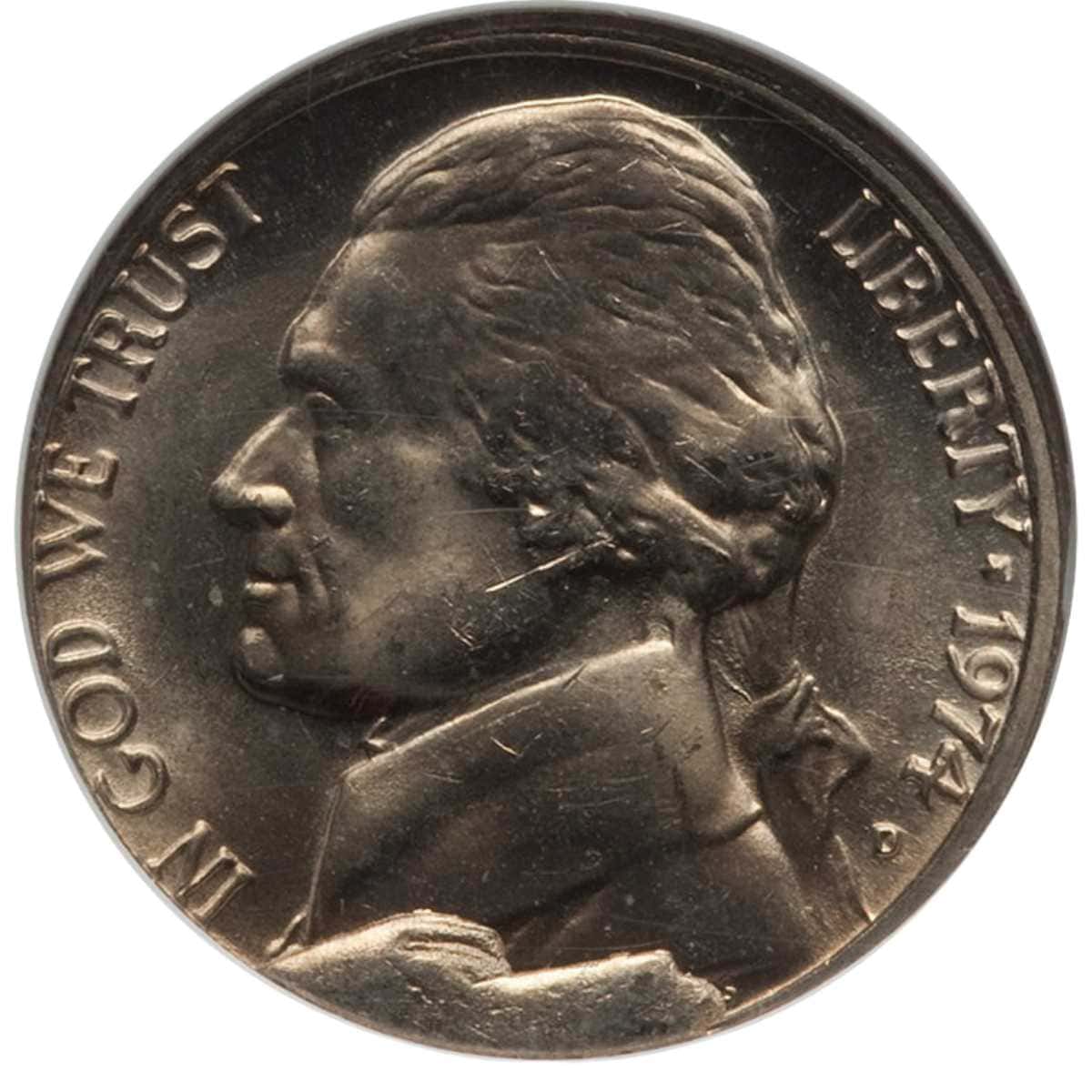The 1974 Nickel is only a few cents ahead of its face value because of the sheer number of mintage. It has three varieties, which merely differ in mintmark and strike characteristics. Additionally, most grades are affordable, with only a few samples reaching a thousand dollars in the open market.
You can expect the 1974 Nickel to sell from $0.10 to $1,750 (depending on the grade and variety). Below, you’ll see the summarized estimated value of each and their Mint origin.
| 1974 Nickel Summarized Value Chart | |||
| Mint Location | Mintage | Coin Series | Value |
|
Philadelphia |
601,752,000 |
1974 5C Regular Strike | $0.10-$200 |
| 1974 5C MS 6FS | $45-$135 | ||
| 1974 5C MS 5FS | $25-$700 | ||
|
Denver |
277,373,000 |
1974-D 5C Regular Strike | $0.10-$1,750 |
| 1974-D 5C MS 6FS | $115 | ||
| 1974-D 5C MS 5FS | $15-$1,500 | ||
|
San Francisco |
2,612,568 |
1974-S 5C PF | $0.30-$12.50 |
| 1974-S 5C PF CAM | $4-$20 | ||
| 1974-S 5C PF DCAM | $10-$25 | ||
1974 Jefferson Nickel Details
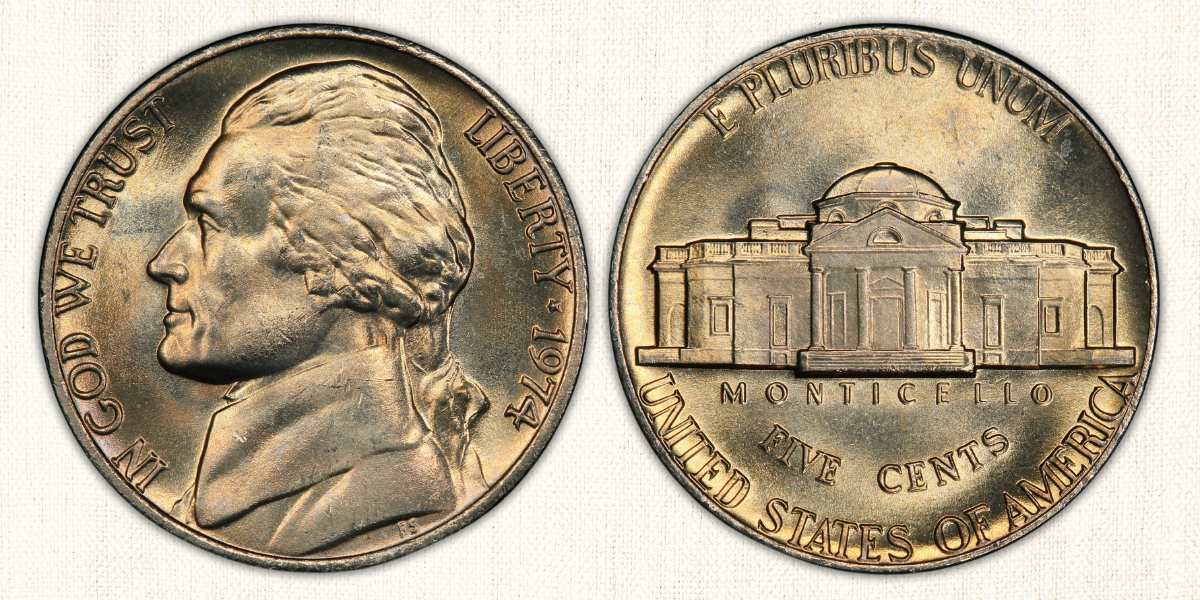
- Category: Jefferson Five Cents (1938 to date)
- Face Value: Five Cents
- Obverse-Reverse Designer: Felix Schlag
- Metal Composition:75% Coppe and 25% Nickel for regular nickels; 40% Silver and60% Copper for 1974-S Proof Nickels
- Weight: 5.00 grams
- Diameter: 21.20 millimeters
- Edge: Plain
Felix Schlag designed the famous Jefferson Nickel after his work won the Mint-sponsored contest in 1938. His design replaced the Indian Head Nickel with the figure of Thomas Jefferson seen on the obverse side.
At the truncation of the bust is the designer’s initial FS, which only appeared in 1966 onward. The words LIBERTY and the Mint year, separated by an ornamental dot, occupy the right field. Lastly, the motto IN GOD WE TRUST is inscribed in the left field of the coin.
On the reverse side, it depicts the architectural masterpiece Monticello, home of the third president. Above it is the motto E PLURIBUS UNUM, and below are the words FIVE CENTS and UNITED STATES OF AMERICA.
With the detailed design of the Motencillo, it is tricky for Mint facilities to perfect all the small-scale features of this design throughout millions of coins produced. That is particularly observable in the steps in Long Tom’s humble abode. So, let’s talk about it as it is one of the determining factors for the coin’s valuation.
Full Steps Designation
A Full Steps (FS) designation appears next to the numerical grade of regular strike coins from MS60 and above. The coin must have at least five clear separations of the steps at the base of Monticello to earn such a title. Some issues almost don’t have samples with Full Steps. So, if you encounter one in grading, it usually commands a significant premium.

Those nickels with 100% Full Steps details have five separate lines (6 steps) and have the 6FS designation. But if it only has four lines (5 steps), 5FS is used in replacement. On the other hand, circulated coins are usually weakly struck with almost no steps visible, making them sell for a lower value.
1974 Nickel Varieties and Valuation
Now that you know how the stair details affect the value of the 1974 nickel, let’s talk about the valuation of each variety.
1974 (P) No Mintmark Nickel Value

In 1974—the Philadelphia Mint surmounted the average production since 1938, releasing over 601 million nickel. With millions that survive today, it makes the 1974 (P) Nickel very common in most grades and the most affordable date compared to other issues.
The circulated conditions range from $0.10 to $0.20, while an uncirculated condition is valued between $0.25 to $200.
Examples with an MS66 grade and above are scarce but can be found and purchased inexpensively with a thorough search. However, those with Full Steps designation are already under the possession of collectors, and only a few go into auction as it is hard to obtain.
Six Full Steps has known grades from MS64 to MS65 that can sell from $45 to $135. On the other hand, Five Full Steps has samples from MS64 to MS66 valued at around $25 to $700.
It is definite that the 1974 (P) Nickel sells lower than other Jefferson Nickel dates, even with FS. But it is also possible for high-grade coins to reach a thousand dollars if placed on open auction. An example is the MS60, sold for $1,783 by Bowers & Merena.
| 1974 (P) Jefferson Nickel Value Chart | |||
| Coin Grade | 1974 5C MS | 1974 5C MS 6FS | 1974 5C MS 5FS |
| Circulated
(G4-XF40) |
$0.10 | / | / |
| About Uncirculated (AU50-AU58) | $0.10-$0.20 | / | / |
| Uncirculated
(MS60-MS64) |
$0.25-$5 | $45-$50 | $25-$40 |
| Gem Uncirculated
(MS65 and above) |
$15-$200 | $125-$135 | $80-$700 |
1974-D Nickel Value
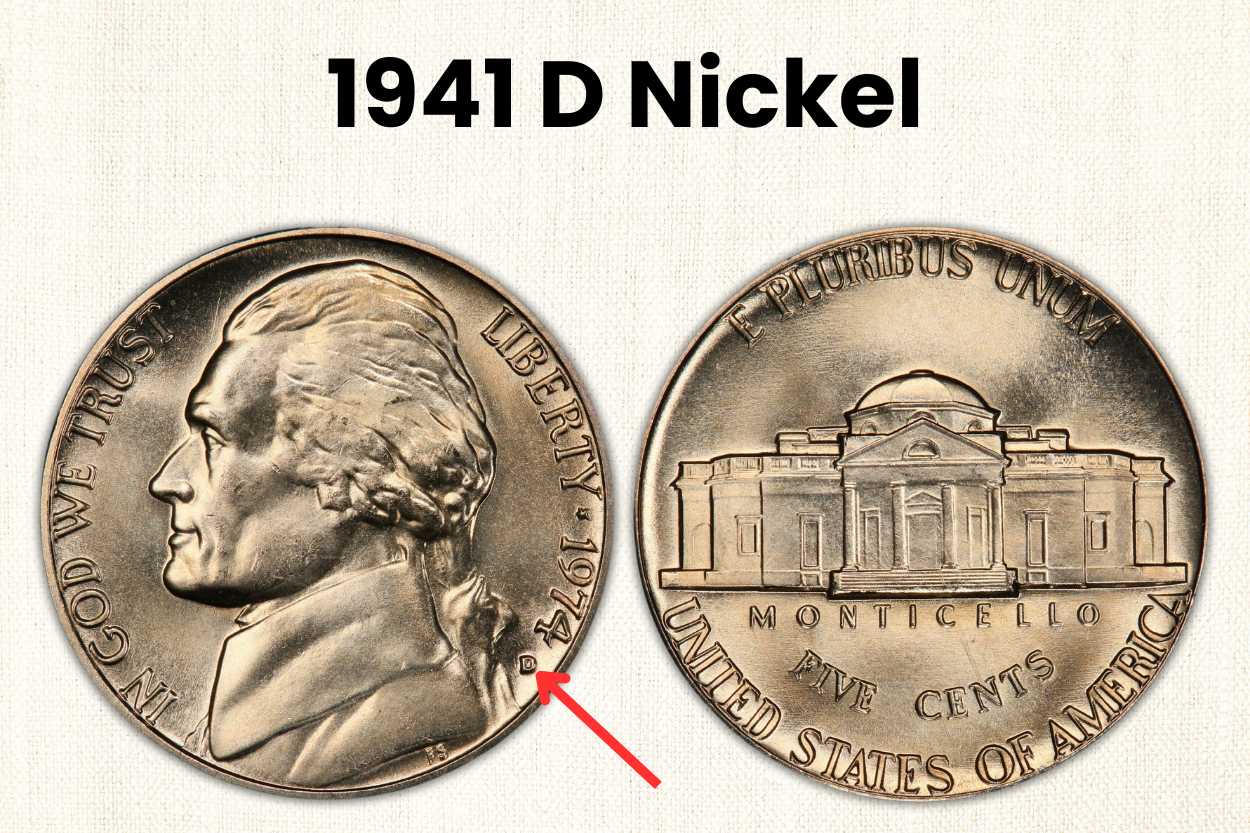
The Denver coin is represented with a D mintmark on the obverse side of a nickel. The Mint produced over 277 million 1974-D nickels, which is fewer in number than other issues.
So, does this make it less common compared to the no-mintmark variety? Predictably, it still had high survival estimates in most grades, even in Mint state conditions. Hundred still exists and has a low-cost value of $0.10 to $0.20 for circulated conditions. Meanwhile, an uncirculated condition can fetch higher from $0.25 to $1,750. A 1974-D in Mint state is a good starting variety if you want a high-grade coin with a mintmark yet economical in the pocket.
Now, in terms of production, the Denver Mint took their production seriously, focusing on good strike characteristics. It is reflected in the number of FS samples available today, and you can purchase it for a reasonable price point.
An MS64 5FS is valued at around $15 to $20, while an MS65 to MS67 can fetch between $25 to $1,500. Contrarily, an MS65 6FS can sell for at least $115, but a higher grade may command a thousand in auctions.
| 1974-D Jefferson Nickel Value Chart | |||
| Coin Grade | 1974 5C MS | 1974 5C MS 6FS | 1974 5C MS 5FS |
| Circulated
(G4-XF40) |
$0.10 | / | / |
| About Uncirculated (AU50-AU58) | $0.10-$0.20 | / | / |
| Uncirculated
(MS60-MS64) |
$0.25-$4 | / | $15-$20 |
| Gem Uncirculated
(MS65 and above) |
$10-$1,750 | $115 | $25-$1,500 |
1974-S Proof Nickel Value
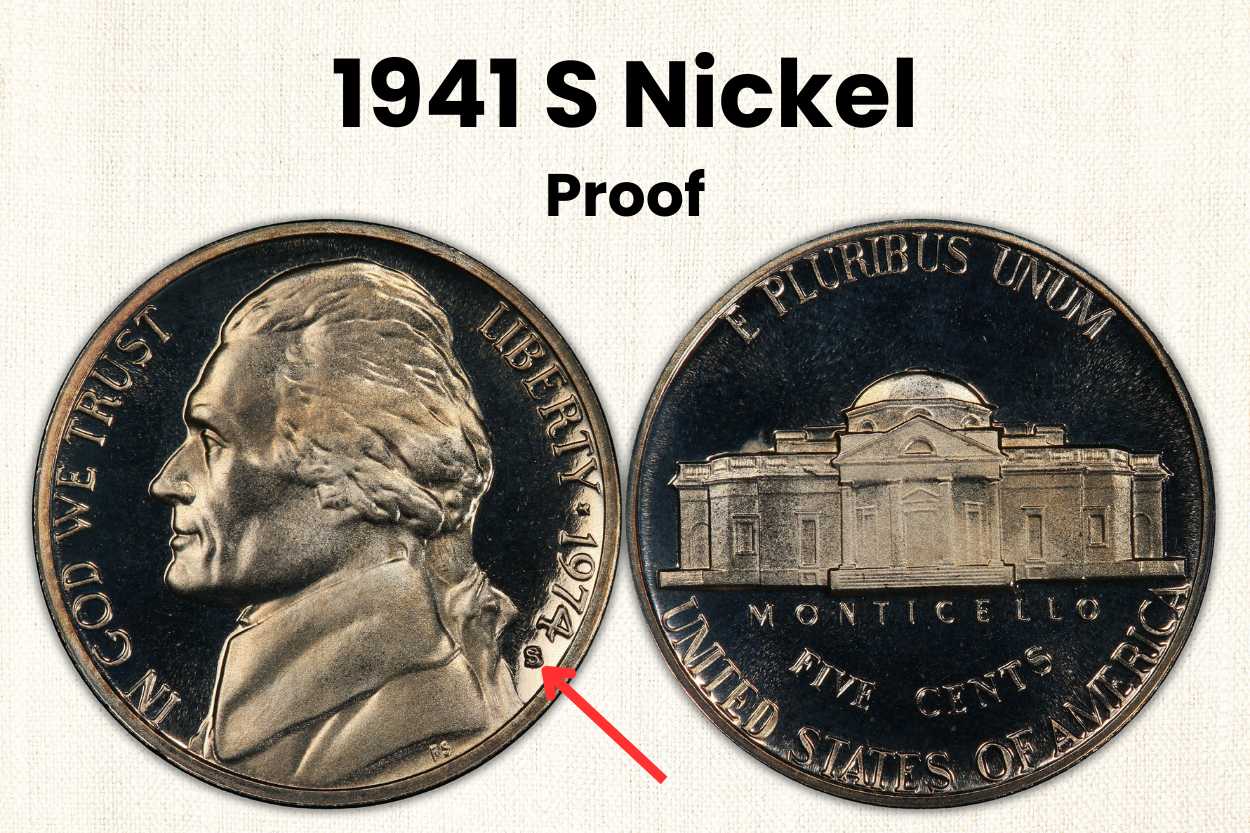
The 1974-S Nickel is among the lucky dates with Proof variety instead of Special Mint Sets. But it is the best that the coin would have it as it does not command much value than the other dates.
A 1974 Proof nickel with impaired or dull luster is valued at $0.30 to $0.75, while those with average strikes and good mint luster can fetch $0.90 to $3.50. Lastly, Proof nickels with sharp strikes and original color can sell for an affordable value of $5 to $12.50.
Aside from the average Proof coins, you’ll also find a Cameo variety for this year. A 1974 PF CAM is relatively common today, with a numismatic value of $4 to $20. PF DCAM also has hefty samples, marketing at $10 to $25.
A perfect PF70, however, is very scarce and expensive. In fact, all samples of DCAM that appeared in the auction sold for not less than a thousand dollars. For example, this PF70 DCAM with a sale price of $2,640 by Heritage Auctions in 2021.
| 1974-S Jefferson Nickel Value Chart | |||
| Coin Grade | 1974 5C PF | 1974 5C PF CAM | 1974 5C PF DCAM |
| PF-60 | $0.30-$0.35 | / | / |
| PF-61 | $0.40-$0.50 | / | / |
| PF-62 | $0.65-$0.75 | / | / |
| PF-63 | $0.90-$1.15 | / | / |
| PF-64 | $1.25-$1.50 | $4 | / |
| PF-65 | $1.75-$2 | $7 | $10 |
| PF-66 | $2.50-$3.50 | $10 | $13 |
| PF-67 | $5-$6 | $13 | $17 |
| PF-68 | $7.50-$9 | $15 | $20 |
| PF-69 | $12.50 | $20 | $25 |
1974 Jefferson Nickel Error Coins
The Jefferson Nickle Series, Original Design, does not have many die varieties that are considered rare. However, a couple of error coins raise the cost dramatically. Here are some of the 1974 error coins and their estimated market value.
1974 Nickel Clipped Planchets Error
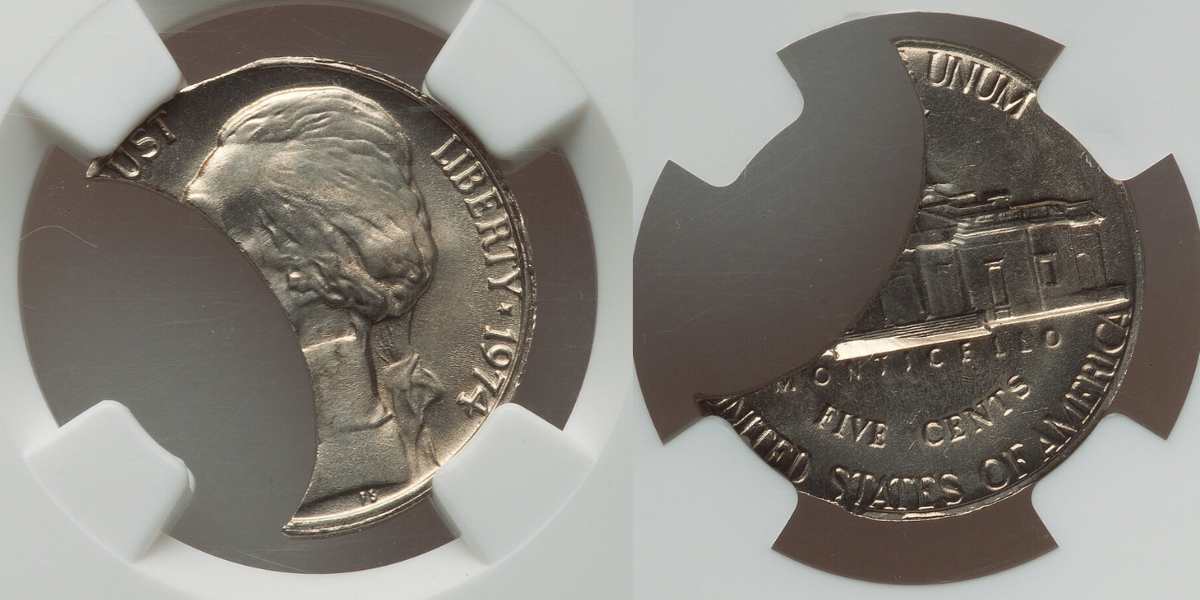
Clipped planchets are easy to spot because of an incomplete metal piece. However, be careful of faked cliped that emerge in the market today. A genuine clipped planchet has a similar arc to that of the coin.
It can be slightly off as striking can deform the edges. Next, the edge of the clipped area has cut and tear marks that usually look jagged. Lastly, the lettering near the clip is somewhat distorted.
If your coin is as described, you can expect it to sell for $5 for circulated conditions. As for higher grades, it can fetch around $50 to $300.
1974 Nickel Die Break Error
Coins with die break is a consequence of using broken dies. Coin dies are made from sturdy steel, but they eventually break after prolonged use and heavy impact. When this happens, the resulting coin will have a full or retained cud. Usually, you’ll spot it near the rim like a clump of raised metal covering some of the original details.
Coins with this error can sell for $5 to $100, depending on the variety and condition.
1974 Nickel Misaligned Die Error

A misaligned die looks similar to an off-center error coin. But the two are actually different. A misaligned die occurs when the hammer is not lined properly with the anvil die, creating a slight offset on one side of the coin. The latter, however, is due to the striking chamber that causes irregularities on both sides.
Coins with this error can sell for about $30 to $60, given that the date is intact.
1974 Nickel Struck on the Wrong Planchet
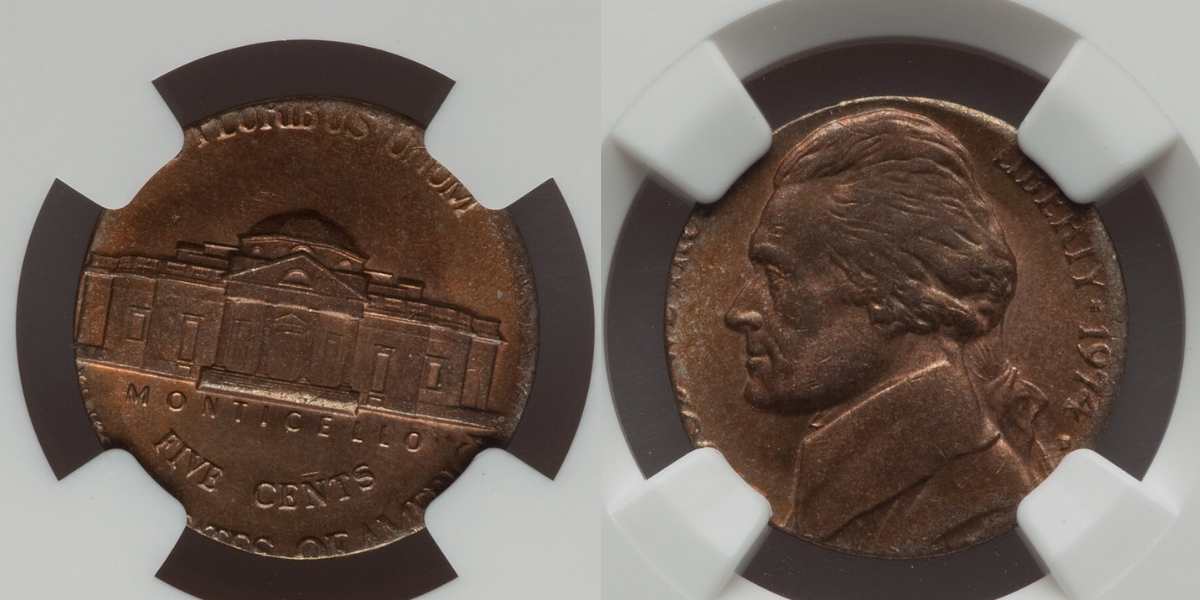
From the name itself, one denomination can get struck on a planchet from a different denomination. It is a typical error for the 1974 nickel issue, which sometimes you’ll find under the double denomination error. A 1974 nickel has samples punched in a quarter and some on a one-cent planchet.
Circulated Jefferson nickel with this error can sell for $150 to $200, while an uncirculated condition can go from $225 to $250.
1974 Nickel Double-Struck Off-Center
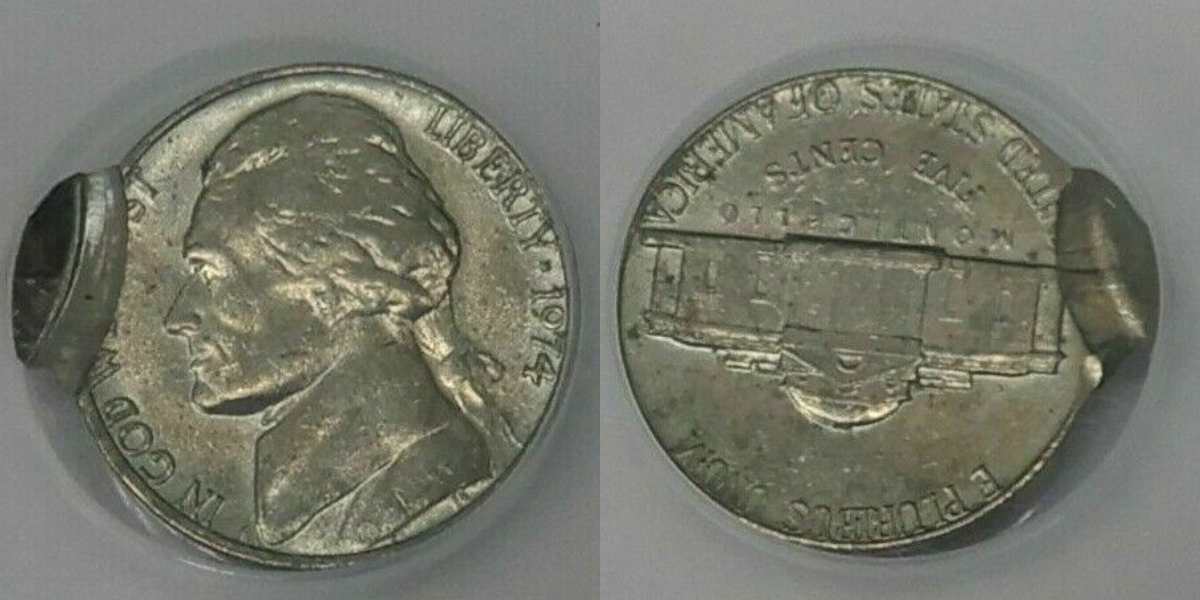
There are four primary types of double-struck error, but the double-struck off-center is the most common. This type of flaw happens when a coin is struck but fails to eject fully between the dies before being struck the second time. The result is a centered first strike with an off-center second strike, deforming the circular coin.
This error type can drastically elevate the coin value from around $50 to $100.
1974 Nickel Broadstruck Error

Coins are struck with a collar to help maintain their original diameter. However, if the coin gets struck outside of the retaining collar, it expands and features a wider coin surface than usual. For Broadstruck, all design elements are still intact, even if they might appear slightly uncentered for both sides.
Coins with a broadstruck error can sell for $5 to $25.
Grading a Jefferson Nickel: Good to Uncirculated
A while ago, we briefly discussed the Full Steps designation that helped determine the value of a coin. But aside from that, here are other points to consider to assess the grade of your 1974 Jefferson Nickel. Here are some of the details from good to uncirculated condition.
Good (G4)
Most nickels that survived today are under this grade because many roll out for circulation. Noticeable wear and flattened details are prominent for Jefferson nickel in good condition. Jefferson’s portrait lacks details, with the hairline merged with the cheeks and forehead. The Monticello has no precise detailing, making the steps and columns hardly recognizable. Lastly, the lettering is almost touching the rim as it flattens.
Fine (F12)
In fine condition, the majority of the intricate details in Jefferon’s hair are missing. The forehead is flattened, merging with the temporal hairline. The columns are still visible on the reverse side, although the triangle roof is absent. Meanwhile, the letters and number details are still sharp, separated from the rim.
Extremely Fine (XF40)
There is light wear and fine luster, with the high points somewhat flattened from use in extremely fine condition. The Montecillo still has fine details, although noticeably worn. Nonetheless, it is a nice condition, with most separation visible.
Uncirculated (MS)
The uncirculated condition has no signs of wear since it has never been in circulation. The coin looks freshly struck, and the Mint luster is still intact. The tiny details, like hairlines and Monticello columns, are bright and have no marks. Overall, it is the condition many collectors aim to get their hands on.


Jenson is a professional numismatist, a dedicated coin collector, a graduate of the College of Business at Oregon State, a life member of the American Numismatic Association (ANA), and an overall coin nerd. He is the founder of Coin Value List.

